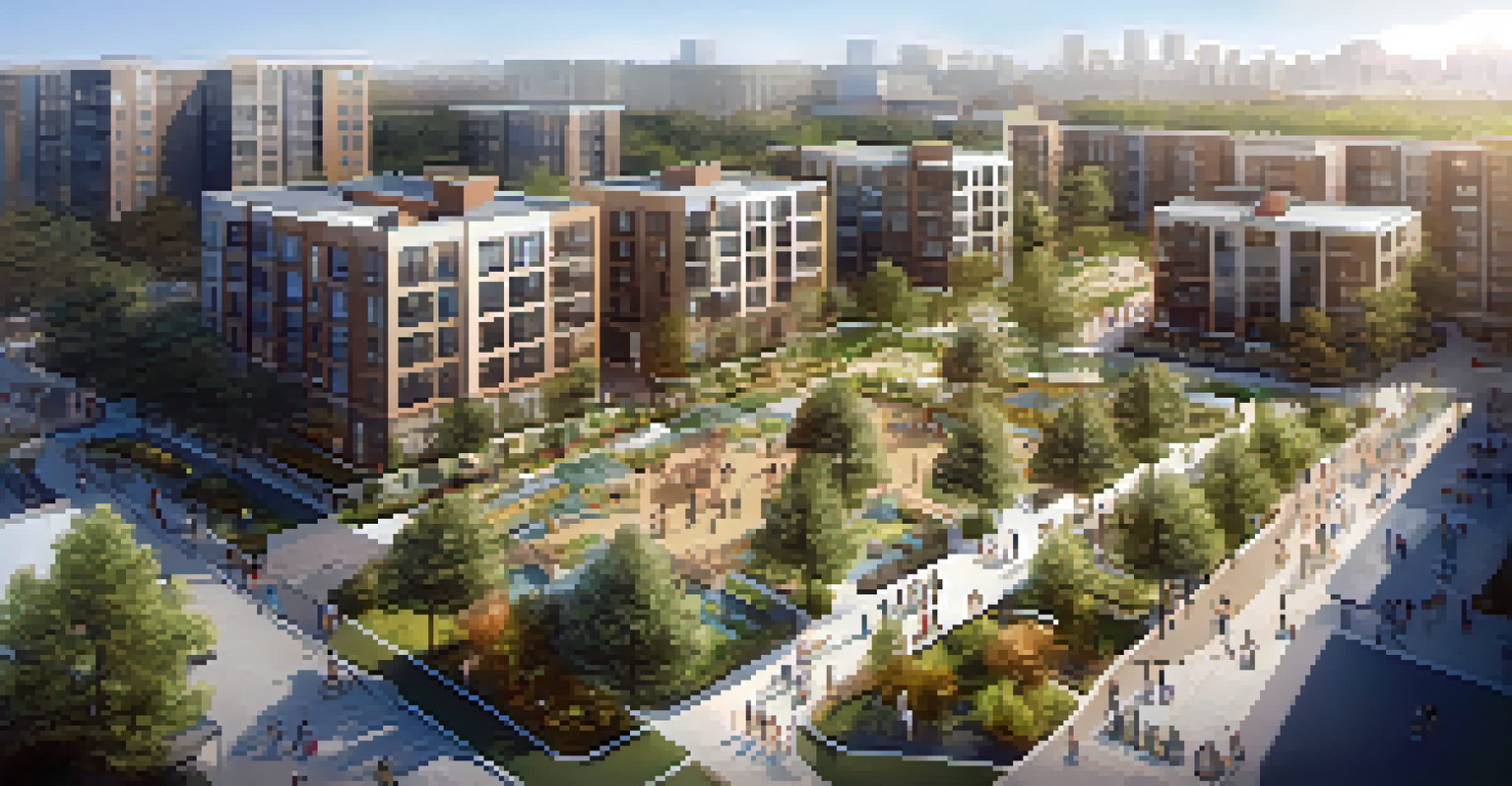The Role of REITs in Urban Development and Planning

What Are REITs and Their Significance in Urban Development?
Real Estate Investment Trusts (REITs) are companies that own, operate, or finance income-producing real estate. They allow individual investors to earn a share of the income generated through commercial real estate ownership without having to buy, manage, or finance any properties directly. This democratization of real estate investment is crucial for urban development, as it opens up funding sources for large-scale projects.
Real estate is an impermanent thing, but it’s also a permanent investment.
By pooling resources from numerous investors, REITs can fund substantial urban infrastructure projects that might be too costly for individual investors. This capability enables cities to finance housing, office buildings, and retail spaces that are vital for urban growth and revitalization. In essence, REITs act as a bridge between investors and urban development needs.
Moreover, REITs contribute to the economic landscape by creating jobs, increasing tax revenues, and improving local amenities. As urban areas continue to evolve, the role of REITs becomes increasingly significant in shaping the environments where we live, work, and play.
The Impact of REITs on Urban Housing Availability
Urban housing shortages are a pressing issue in many cities, and REITs play a pivotal role in addressing this challenge. By investing in residential properties, REITs can increase the supply of rental units, which helps stabilize or even lower rental prices in high-demand areas. This is particularly important in cities where affordable housing is scarce.

For instance, a REIT specializing in multifamily housing can acquire, renovate, and manage apartment complexes, making them more livable and accessible. Such investments not only enhance the quality of housing but also contribute to urban density, which can lead to more vibrant communities. An increase in housing options can lead to diverse neighborhoods, attracting a mix of residents.
However, the relationship between REITs and housing is not without challenges. Critics argue that some REITs prioritize profit over community needs, potentially leading to gentrification. It’s essential for REITs to balance profitability with social responsibility, ensuring that their developments meet the needs of current residents while also welcoming newcomers.
REITs and Sustainable Urban Development Practices
Sustainability is becoming a key consideration in urban planning, and REITs are increasingly aligning their strategies with green principles. Many REITs are investing in environmentally sustainable buildings that reduce energy consumption and carbon footprints. This shift not only meets regulatory requirements but also appeals to socially-conscious investors and tenants.
Sustainability is about more than just the environment; it’s about making our cities more livable and our communities more vibrant.
For example, a REIT might focus on developing properties that utilize renewable energy sources, such as solar panels, or those with efficient water usage systems. Such practices not only help the environment but can also lead to cost savings over time, creating a win-win situation for both the REIT and the community. Sustainable buildings can significantly enhance the livability of urban spaces.
Additionally, REITs that prioritize sustainability often find themselves in a better position when it comes to attracting tenants. Many modern renters prefer living in eco-friendly buildings, which adds another layer of demand for sustainably developed properties. Thus, the integration of sustainable practices within REIT investment strategies plays a vital role in shaping the future of urban landscapes.
The Role of REITs in Revitalizing Urban Areas
Urban areas often face challenges such as blight and economic decline, and REITs can be instrumental in revitalizing these neighborhoods. By investing in underdeveloped or distressed areas, REITs can help inject much-needed capital and attention into places that may have been overlooked. These investments can lead to improved infrastructure and amenities, which benefit the community as a whole.
For instance, a REIT can acquire an abandoned shopping mall and transform it into a mixed-use development featuring retail, office space, and housing. This not only brings life back to a previously stagnant area but also creates job opportunities and increases local tax revenues. Revitalization projects like these can serve as catalysts for broader community improvements.
Furthermore, successful revitalization efforts can enhance the overall image of a city, making it more attractive for tourists and new residents alike. As REITs take on such projects, they play a crucial role in shaping the narrative of urban renewal, demonstrating how targeted investments can lead to thriving communities.
How REITs Influence Urban Infrastructure Development
Urban infrastructure, including roads, public transport, and utilities, is essential for the functioning of cities. REITs can influence this infrastructure development by investing in properties that require enhanced access to these services. As these properties develop, they often spur improvements in infrastructure, benefiting not just the tenants but the entire community.
For example, a REIT developing a large office building may advocate for better public transportation options to accommodate its workforce. This can lead to new bus lines or improved rail services, which serve the dual purpose of enhancing the REIT's investment while also improving mobility for local residents. Such developments can significantly alter the urban landscape, making cities more navigable.
Moreover, by collaborating with local governments and planning agencies, REITs can help align their development projects with broader urban planning goals. This partnership can ensure that infrastructure improvements are strategically implemented, resulting in well-planned urban environments that meet the needs of current and future residents.
REITs and Economic Growth in Urban Areas
The economic impact of REITs on urban areas is profound, as they stimulate job creation and contribute to local economies. By investing in commercial properties, REITs help establish businesses that generate employment opportunities. These jobs can range from construction and management to retail and hospitality, creating a ripple effect in the local economy.
Additionally, REIT investments can lead to increased tax revenues for municipalities, which can then be reinvested into community services and infrastructure. For example, as a REIT develops a new commercial center, the local government may see a boost in sales tax from increased retail activity. This revenue can be pivotal for funding schools, parks, and public safety initiatives.
However, while REITs can drive economic growth, it is essential for cities to ensure that this growth is equitable. Urban planners and policymakers must work alongside REITs to ensure that development benefits all residents, not just investors. A balanced approach can lead to sustainable economic environments that foster community well-being.
Challenges REITs Face in Urban Development and Planning
Despite their positive contributions to urban development, REITs encounter several challenges in this landscape. Market fluctuations, regulatory hurdles, and community opposition can all impact the success of REIT projects. For instance, economic downturns can lead to decreased demand for commercial properties, affecting the profitability of REIT investments.
Moreover, navigating local zoning laws and regulations can be daunting for REITs. Each city has its own set of guidelines regarding property development, and failing to adhere to these can result in delays or project cancellations. Understanding and working within these frameworks is essential for REITs to successfully contribute to urban planning.

Community opposition can also pose a significant challenge. Residents may resist new developments due to concerns about gentrification or changes in neighborhood character. To address these issues, REITs must engage with local communities, listen to their concerns, and work collaboratively to find solutions that benefit everyone involved. This proactive approach can help mitigate tensions and foster a more supportive environment for urban development.
The Future of REITs in Urban Development and Planning
Looking ahead, the role of REITs in urban development and planning is likely to evolve in response to changing market dynamics and societal needs. As cities continue to grow and face new challenges—such as climate change and housing shortages—REITs will need to adapt their strategies accordingly. This adaptability will be crucial for ensuring they remain relevant and impactful in urban environments.
Innovations in technology and building practices will also shape the future of REITs. Embracing smart building technologies and sustainable construction methods could become standard practice, enhancing the efficiency and appeal of urban properties. This trend aligns with the growing demand for environmentally friendly and technologically advanced living and working spaces.
Ultimately, the future of REITs will depend on their ability to collaborate with stakeholders, including local governments, communities, and investors. By fostering these relationships and prioritizing social responsibility, REITs can continue to play a vital role in shaping vibrant, sustainable urban landscapes for years to come.